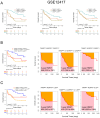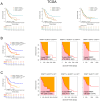Analysis of prognostic biomarker models of TXNIP/NLRP3/IL1B inflammasome pathway in patients with acute myeloid leukemia
- PMID: 38903927
- PMCID: PMC11186430
- DOI: 10.7150/ijms.96627
Analysis of prognostic biomarker models of TXNIP/NLRP3/IL1B inflammasome pathway in patients with acute myeloid leukemia
Abstract
Background: Exploring potential biomarkers for predicting clinical outcomes and developing targeted therapies for acute myeloid leukemia (AML) is of utmost importance. This study aimed to investigate the expression pattern of the thioredoxin-interacting protein (TXNIP)/nucleotide-binding oligomerization domain (NOD)-like receptor protein 3 (NLRP3) pathway and its role in the prognosis of AML patients. Methods: In this study, we examined the prognostic value of TXNIP/NLRP3 pathway in AML patients using microarray data from Gene Expression Omnibus (GEO) and transcriptome data from the Cancer Genome Atlas (TCGA) to develop a prognostic model and validated the results by quantitative real-time PCR (qRT-PCR) in a validation cohort of 26 AML patients and 18 healthy individuals from Jinan University (JNU) database. Results: Analysis of the GSE13159 database revealed that TXNIP, interleukin 1 beta (IL1B) within the TXNIP/NLRP3 pathway were significantly upregulated and caspase1 (CASP1) was downregulated in AML patients (TXNIP, P = 0.031; IL1B, P = 0.042; CASP1, P = 0.038). Compared to high NLRP3 expression, AML patients with low NLRP3 expression had a longer overall survival (OS) in the GSE12417 dataset (P = 0.004). Moreover, both the training and validation results indicated that lower TXNIP, NLRP3, and IL1B expression were associated with favorable prognosis (GSE12417, P = 0.009; TCGA, P = 0.050; JNU, P = 0.026). According to the receiver operating characteristic curve analysis, this model demonstrated a sensitivity of 84% for predicting three-year survival. These data might provide novel predictors for AML outcome and direction for further investigation of the possibility of using TXNIP/NLRP3/IL1B genes in novel targeted therapies for AML.
Keywords: Acute myeloid leukemia; NLRP3; TXNIP; biomarker; prognosis.
© The author(s).
Conflict of interest statement
Competing Interests: The authors have declared that no competing interest exists.
Figures




Similar articles
-
Nod-like receptor protein 3 (NLRP3) inflammasome activation and podocyte injury via thioredoxin-interacting protein (TXNIP) during hyperhomocysteinemia.J Biol Chem. 2014 Sep 26;289(39):27159-27168. doi: 10.1074/jbc.M114.567537. Epub 2014 Aug 19. J Biol Chem. 2014. PMID: 25138219 Free PMC article.
-
PARP-1 regulates inflammasome activity by poly-ADP-ribosylation of NLRP3 and interaction with TXNIP in primary macrophages.Cell Mol Life Sci. 2022 Jan 30;79(2):108. doi: 10.1007/s00018-022-04138-z. Cell Mol Life Sci. 2022. PMID: 35098371 Free PMC article.
-
Imbalance in thioredoxin system activates NLRP3 inflammasome pathway in epicardial adipose tissue of patients with coronary artery disease.Mol Biol Rep. 2021 Feb;48(2):1181-1191. doi: 10.1007/s11033-021-06208-0. Epub 2021 Feb 10. Mol Biol Rep. 2021. PMID: 33566225
-
Inhibition of NLRP3 inflammasome by thioredoxin-interacting protein in mouse Kupffer cells as a regulatory mechanism for non-alcoholic fatty liver disease development.Oncotarget. 2017 Jun 6;8(23):37657-37672. doi: 10.18632/oncotarget.17489. Oncotarget. 2017. PMID: 28499273 Free PMC article.
-
Omics approaches: Role in acute myeloid leukemia biomarker discovery and therapy.Cancer Genet. 2025 Apr;292-293:14-26. doi: 10.1016/j.cancergen.2024.12.006. Epub 2025 Jan 3. Cancer Genet. 2025. PMID: 39798496 Review.
Cited by
-
Integrated single-cell and bulk RNA dequencing to identify and validate prognostic genes related to T Cell senescence in acute myeloid leukemia.Front Bioinform. 2025 Jun 25;5:1606284. doi: 10.3389/fbinf.2025.1606284. eCollection 2025. Front Bioinform. 2025. PMID: 40635996 Free PMC article.
-
Impact of single nucleotide polymorphisms of immunomodulatory factors on treatment response and prognosis in acute myeloid leukemia.Front Immunol. 2025 Mar 31;16:1571332. doi: 10.3389/fimmu.2025.1571332. eCollection 2025. Front Immunol. 2025. PMID: 40230861 Free PMC article.
-
Integrative multi-omic analysis of NLRP3 inflammasome dysregulation and subtyping for personalized treatment in acute myeloid leukemia.Discov Oncol. 2025 Jul 2;16(1):649. doi: 10.1007/s12672-025-02383-9. Discov Oncol. 2025. PMID: 40593281 Free PMC article.
-
Prognostic value of natural killer T cell related genes in acute myeloid leukemia.Cancer Cell Int. 2025 Apr 13;25(1):143. doi: 10.1186/s12935-025-03779-x. Cancer Cell Int. 2025. PMID: 40223063 Free PMC article.
References
-
- Döhner H, Weisdorf DJ, Bloomfield CD. Acute Myeloid Leukemia. New England Journal of Medicine. 2015;373:1136–1152. - PubMed
-
- Shallis RM, Wang R, Davidoff A, Ma X, Zeidan AM. Epidemiology of acute myeloid leukemia: Recent progress and enduring challenges. Blood Rev. 2019;36:70–87. - PubMed
-
- Bewersdorf JP, Huntington SF, Zeidan AM. Cost-Effectiveness Analyses in AML: What Have We Learned, How Should This Impact Patient Care, and What Needs to Be Done in the Future? J Natl Compr Canc Netw. 2023;21:522–528. - PubMed
MeSH terms
Substances
LinkOut - more resources
Full Text Sources
Medical

